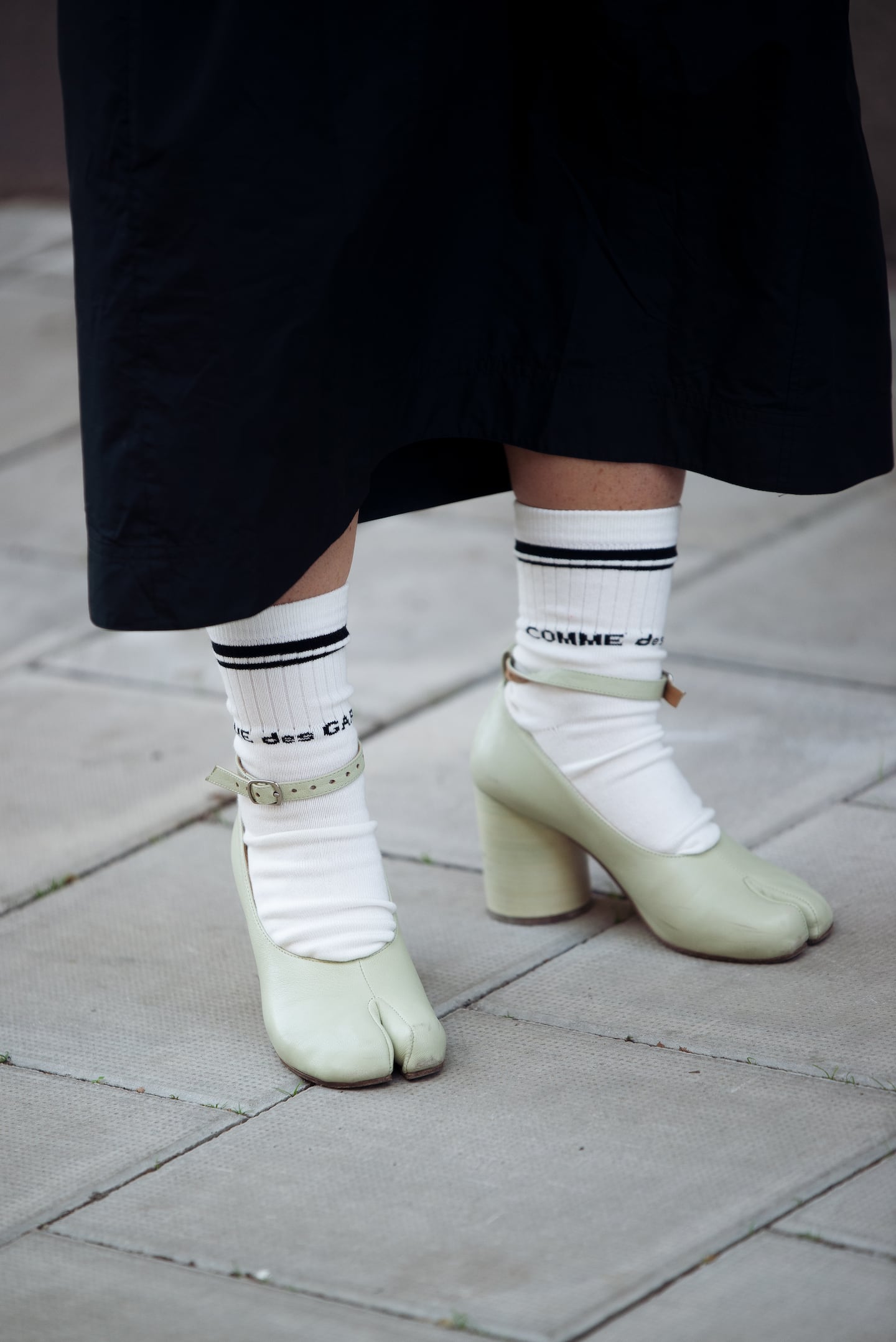
The Business of Fashion
Agenda-setting intelligence, analysis and advice for the global fashion community.

Agenda-setting intelligence, analysis and advice for the global fashion community.

On Sept. 1, TikTok user Nextlevellexus, real name Alexis Dougé, took to the app to alert the masses: keep your Tabi boots close and your Mary Janes closer.
On the app, Dougé shared a story of a Tinder date gone wrong, that ended with her match stealing her Maison Margiela Tabi Mary Jane shoes out of her closet and deleting his number from her phone, leaving Dougé with no way to track him — or the missing footwear — down.
The post quickly went viral, amassing 1.4 million views (and counting). Commenters dubbed her date the “Tabi Swiper” and followed along as Dougé plotted to get her shoes back. (Eventually, he returned the shoes — but not before attempting to gift them to his now ex-girlfriend.)
From the start, the saga had all the makings of a viral moment: sex, lies and a catchy nickname. But the key ingredient was Maison Margiela’s Tabi, a split-toe shoe, which has been applied to styles ranging from boots to Mary Janes. Designer Martin Margiela first debuted the animalistic, hoof-print shoe in his Spring/Summer 1989 collection, and it went on to become a cult fashion item — especially amongst artsy types — in the early aughts.
ADVERTISEMENT
Though they’ve been around for decades, the “Tabi Swiper” incident pushed conversation about the cloven style to a new high, laying the groundwork for more mainstream adoption. So far this year, searches for Tabis on Depop have increased 110 percent and 40 percent on Lyst over 2022. In the month of September, searches on Lyst more than doubled. Supply is expected to build in the coming weeks, said The RealReal director of merchandising Sasha Skoda.
The Tabi has become a shorthand for a certain level of subcultural, internet-literate fashionability. As Maison Margiela chief executive Gaetano Sciuto put it in an email, the Tabi is “a strong aggregator of like-minded people.”
“This story couldn’t have happened with a different type of shoe… The Tabi is sort of like a character in a fairy tale that everyone knows,” said Thom Bettridge, head of creative and content at online retailer Ssense.
Even before conversation peaked, retailers were upping their commitment to the style: new Tabi arrivals online in the US and UK have grown 56 percent year-to-date in 2023 compared to the same period in 2021, according to retail intelligence firm Edited.
Margiela’s commitment to the Tabi — constantly re-engaging it with new shapes and collaborations — has created a cult around it, setting the stage for its viral moment. Now that the internet has created a frenzy around the Tabi, that newfound awareness could help fuel sales.
“When I first started wearing my Tabis, I would get comments and looks, people loved it or hated it,” said Sara Wong, vice president, footwear, leather goods and accessories at Canadian department store Holt Renfrew. “Now that you have all these stories and viral elements connected, it makes it a little more mainstream.”
The shoe has long been a mainstay for the Margiela business — both as a sales driver and a touchstone for brand heritage. But the silhouette’s history goes back before Margiela, tracing its roots to Japanese two-toed tabi socks, which date back to the 15th century, and are designed to help with foot alignment and worn with traditional thong sandals.
Though Margiela’s version debuted long before Instagram, it’s a style made for the internet. The uncanny, make-you-look-twice design fuels a sense of camaraderie between fans and perennial debate (sometimes hate) among everyone else. Much of the conversation that spun off the Tabi Swiper narrative was negative, consumer intelligence firm Brandwatch found, as people online called the shoe too ugly or too expensive.
ADVERTISEMENT
Still, for those who get it, the controversy is part of the appeal.
“Because it’s such a simple and elegant disruption of a shoe, it really lends itself to young people creating identity around fashion and playing with it,” said Bettridge.
That “if you know, you know” status and experimental nature have created a sort of lore around the shoe. There have always been “Tabi people” — most often Margiela devotees or fervent, creative and urbanite fashion lovers, and non-Tabi people, said Bettridge, but the definition of who is a “Tabi person” is expanding.
“There was a time when you had to buy certain magazines to even know what it was,” said Bettridge. “Now, anyone with an iPhone can learn about it.”
Younger people, especially, are buying into the trend: Gen-Z led the most discussion about the item across social media in the past two years, Brandwatch found.
Part of the style’s longevity has to do with how Maison Margiela leverages it. The brand constantly refreshes its mix: every season, the brand releases Tabis in new silhouettes, such as slippers and cowboy boots; patterns and colours like metallics; or materials like transparent PVC. Margiela has also collaborated with Nike and Reebok on new Tabi styles.
This strategy not only gives the most devoted fans reasons to keep buying, but it makes it easier for anyone to buy in. A Tabi veteran will buy a boot or bold colour, while a newbie looks to ballet flats and muted tones, said Wong. Once they start buying, too, customers usually don’t just stop at one pair.
“It’s very addictive … you start with black and end up venturing into silver, metallic or red colours,” said Wong.
ADVERTISEMENT
While the world reached peak Tabi in September thanks to the Swiper, the design was already gaining in the internet’s consciousness, seen on celebrities like Dua Lipa and Nick Jonas. The hashtag #Tabishoes has nearly 16 million views on TikTok.
Logo fatigue may also be playing a part in the shoe’s present popularity.
“We’re seeing people shift away from the logo and monogram but still wanting to telegraph brand affinity,” said Bettridge. The split-toe look is synonymous with Margiela, without plastering its name across the product.
This growing interest and widening appeal could give the retailers who stock Tabis — and Margiela itself — a boost. Sell-outs are up slightly from last year, and up 36 percent compared to 2021, according to retail intelligence firm Edited. The styles are set at a relatively low discount rate: 98 percent of Tabi shoes currently available online are listed at full price, according to retail analytics firm Trendalytics. For comparison, 67.4 percent of Mary Jane shoes overall sit at full price.
Beyond a margin driver, the shoe has become a talking point for retailers like Ssense who drive comments and community by referencing the shoe on social media, and through content like its “History of the Tabi” article published earlier this year. The Tabi has helped Canadian department store Holt Renfrew attract new customers, and guide more traditional shoppers toward edgier items. Wong said the company will double its buy of the style and do more Tabi-centric activations next year.
“We see potential with the opportunity. It’s at the cusp of more cult-y and being commercial,” said Wong.
When fantasy collides with reality, there’s only one winner, as Schiaparelli’s Daniel Roseberry found out on Monday.
Sciuto will take up the chief executive role at the OTB-owned label next month, succeeding Gianfranco Gianangeli.

Joan Kennedy is Editorial Associate at The Business of Fashion. She is based in New York and covers beauty and marketing.
Often left out of the picture in a youth-obsessed industry, selling to Gen-X and Baby Boomer shoppers is more important than ever as their economic power grows.
This month, BoF Careers provides essential sector insights to help PR & communications professionals decode fashion’s creative landscape.
The brand’s scaled-back Revolve Festival points to a new direction in its signature influencer marketing approach.
Brands selling synthetic stones should make their provenance clear in marketing, according to the UK’s Advertising Standards Authority.